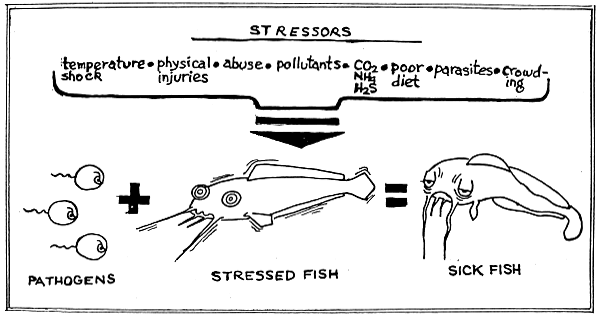
Over time, each species of fish has evolved to fit into the environment in which it is found. Because the species has evolved over thousands of years to a particular environment, that environment can be termed to be the optimum environment.
As fish keepers, when we know a species’ optimum environment, we can then modify an aquariums set-up to most closely suit that species. Some examples of possible modifications include the size of the tank, the amount or colour temperature of the light, the pH, the waters hardness, and temperature, to name a few. The amount of difference between a fishs native optimum environment and the aquarium in which they are to be housed can be the difference between that fishs ability to thrive or to just survive.
When an individual fish is wild-caught or only one or two generations removed from being wild-caught, the more important it is that the captive environment matches as closely as possible to the fishs optimum environment. Some species of fish can thrive for years when only one or two of the environmental factors is changed. Some fish-keepers, for example, keep discus in a hard, alkaline water, while others might keep angelfish routinely at 70-72 degrees F. instead of the preferred 78-80 degrees F., and often, in these conditions, the fish will live and even thrive for years.
The purpose of this article is to examine the cumulative effects of stress on a fish when it is kept in an improper environment. A fish which prefers soft water can be raised in hard water; however, if the temperature is also too low, or if the food quality is poor as well, then it takes much less additional stress to kill the fish, whereas in its optimum environment, the fish would easily be able to shrug off the burden and survive. Often, when a fish species is kept in an optimal environment, it will live much longer, be more robust, colourful and active than a fish kept in a poorer quality environment.
Take, for example, angelfish. They prefer a warm, soft water environment, with slow water movement, an acidic pH, and top-quality foods. If provided with all of these factors, the fish are much more resistant to disease and stress, and at the same time, more resilient in recovery when problems do arise. Should the angels be kept at cooler temperatures or in a hard water aquarium all the time, they are more likely to suffer from an additional factor like a sudden temperature drop or an unexpected long gap between feedings.
The more differences that exist between the optimum environment of a species and the aquarium they live in, the more stress becomes piled on. There are people who brag about not needing to perform water changes because their tank is crystal clear, and therefore, clean.” Many of those people dont realise that they are creating a nasty time bomb – suddenly, there is a temperature drop due to heater failure, or a fish becomes singled out as the target of a more aggressive fishs bullying and becomes sick – this scenario can often result in a catastophic wipe-out of the tanks inhabitants. The last straw CAN break the camels back.
If angelfish are kept in poor water conditions and fed poor foods, they not only have a shorter life span, but are also weaker. Add in other failures to meet the optimum environments standard such as maintaining a low water temperature, and/or harassment from other fish, or any other environmental factor, and these fish may soon be dying or dead. Disease will spread faster, cutting down precious time to diagnose and treat the problem, and the disease becomes more likely to be lethal.
When a novice fish-keeper sees the first sign of disease, he will often medicate immediately to treat the disease. Experienced fish-keepers have learned that sometimes the environment alone can make a fish sick, and that adding medicine to a poor environment only makes the problem worse.
If your fish suddenly become sick, sluggish, or go off their food, perhaps the fishs environment should be the first possible cause to be carefully examined. Frequently, if environmental problems are first corrected, the fish may then heal themselves, and if the correction to conditions is quite enough to enable the fish to heal themselves, then they will certainly respond more favorably and quickly when medication is required.
By watching your fish on a daily basis, the fish-keeper gains a better understanding and perspective of what the fishs true natural behavior should be, and then environmental problems can be detected early and therefore, corrected early before a fishs health has deteriorated beyond the point of no return.
Leave a Reply